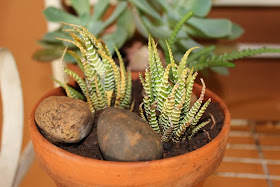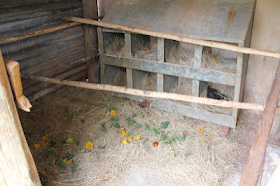“Some people change their ways when they see the light; others when they feel the heat”
- Caroline Schoeder
This year is ending in a BIG bang of a heat wave - we've been suffering temperatures way up in the 30℃'s and heat like this just changes me completely. I end up feeling totally listless and can't get round to doing anything. My brain seems to shrivel and I don't seem to have any clear thoughts. I enjoy temps in the early 20℃'s, then I'm at my happiest.
Even the chickens have been walking around gasping with open mouths and trying to find some solace having sand baths in the cool ground that I've wet for them. Normally I like standing with the hosepipe in my hand, day-dreaming while I give the garden a good wash, but lately I've been putting the sprinkler on and dashing inside to the cool of the aircon.
But on the positive side, we've had lots of rain in the afternoons which helped cool things a bit and my garden is smiling! And nobody shows gratitude like Marigolds do! My kind-hearted gardener, Chrissie, once strew a couple of seeds somewhere in the garden and since then I’ve had them come up in the most unexpected places!
If you grow a vegetable garden, plant Marigolds amongst the vegetables. Marigolds are easy to grow and they help keep away aphids. The relationship between plants and insects is known as ‘companion planting’ and it’s by far the safest, natural way to garden organically. By using companion planting, many gardeners find that they can discourage harmful pests without losing the beneficial allies. There are many varieties of herbs, flowers, etc. that can be used for companion plants. Be open to experimenting and find what works for you.
Some suggestions are AMARANTH which is host to predatory ground beetles which eat the young leaves in salads. ANISE deters pests from brassicas by camouflaging their odor. BASIL: Plant with tomatoes to improve growth and flavour. Basil also does well with peppers, oregano, asparagus and petunias. Basil can be helpful in repelling thrips. It is said to repel flies and mosquitoes. BORAGE deters tomato hornworms and cabbage worms. CHERVIL keeps aphids off lettuce and is said to deter slugs. And COMFREY is a good trap crop for slugs.

Annual Marigolds can be used anywhere to deter bean beetles, squash bugs, thrips, tomato hornworms, and whiteflies. They are also known to repel harmful root knot nematodes (soil dwelling microscopic white worms) that attack tomatoes, potatoes, roses, and strawberries. The root of the Marigold produces a chemical that kills nematodes as they enter the soil. If a whole area is infested, at the end of the season, turn the Marigolds under so the roots will decay in the soil. You can safely plant there again the following spring.
Another great use of Marigolds is for freshening up the chicken coop. I mix them with nasturtiums, lavender, rosemary and sage, cut them up and sprinkle on the coop bedding. The lovely smells are released as the chickens trample on the 'coop potpourri', keeping the coop sweet smelling.
Nasturtium is another annual, in this case a trailing vine, that keeps away potato bugs, squash bugs, and whiteflies. There is nothing not to like about nasturtiums. The petals are bright, vibrant shades of red, yellow and orange. They grow no matter how sandy the soil and the more sun the better. Shade greatly reduces the amount of blooms each plant will produce. Nasturtiums are common companion plants, so plant them with vegetables. They can be used to trap aphids, but mostly they repel insects, particularly squash bugs. When planted in proximity, nasturtiums are also said to make cucumbers taste better!

The colourful blossoms are edible themselves. Nasturtiums make an appealing salad topping for both their look and taste. As a variation of flavoured butter, try mixing together butter, lemon juice and chopped nasturtium blossoms for a mildly, peppery butter, which enhances chicken fish and dips. For a great starter, the blossoms can be stuffed with a mixture of cream cheese or ricotta cheese, chives and pesto. Guacamole also works well as a filling for the blossoms. The blossoms are fairly fragile, so gently pipe the filling down the throat of the blossom.

Nasturtium vinegars can be made using the blossoms. Place a variety of different coloured blossoms in a bottle (the more you add, the more ‘peppery’ the vinegar will be), add a clove of garlic and cover with white wine vinegar (make sure the blossoms are totally submerged). Leave to infuse for 4 weeks or so and the vinegar is then ready to use in salads or sauces. As the blossoms lose their colour after a while, remove and replace with fresh blossoms.
While I'm on the subject of companion planting, I'd also like to mention Sunflowers. They are great companions and beautiful throughout the garden. Plant with Cucumbers, beans, and vining plants to provide a trellis. They are hardy and a great trap crop for aphids and other pests. They typically produce plenty of their own seeds to use next year and I usually harvest the dry heads for my Cockatoo, who just loves to pick out the seeds himself.


Sunflowers grow best in locations with full sun. They are remarkably tough and will grow in any kind of soil as long as it is not waterlogged. They do fine in soils that are slightly acidic to somewhat alkaline (pH 6.0 to 7.5). Once sunflowers get started, they can tolerate drought as befits plants whose ancestors grew happily in dry prairie regions. They are so easy to grow that they often plant themselves, springing up unbidden beneath a bird feeder. Sunflower seed, leaves and stems emit substances that inhibit the growth of certain other plants. They should be separated from potatoes and pole beans. Where sunflower seeds are regularly used as bird feed, toxins from the accumulated seed hulls eventually kill the grass below. Harmless to animals or people, the toxins eventually biodegrade in the soil.

Sunflower seeds are rich in vitamins, proteins, and minerals, as well as linoleic acid which helps the body metabolize fats properly. They contain about 24 to 27 percent protein, only slightly less than an equal weight of ground beef. Furthermore, sunflower seeds contain about twice the iron and potassium and about 4 times the phosphorus of beef. Raw sunflower seeds also contain vitamins B and E, and a dash of vitamin A. Sprouted, they also contain vitamin C. Use the seeds for snacks, alone or mixed with raisins, dried fruit chips, and nuts. Add hulled sunflower seeds to salads and use them in fruit or vegetable recipes. Substitute sunflower seeds for nuts in baking.
And once those seeds ripen, you'll have a plethora of birds visiting to snack on them!
A cool summer snack - Apple and Sunflower Seed Salad
4 to 6 servings
2 green apples - washed, cored and cubed
1/2 cup sunflower seeds
1 head lettuce of your choice - rinsed, dried, and chopped
2 dill pickles,
diced
2 tomatoes,
diced
1/2 cup ranch-style salad dressing
I hope you enjoy companion planting as much as I do, especially the eating part!
(This recipe from
'AllRecipes.com')
.














































 Pachyveria in a pot
Pachyveria in a pot





